Part 2: Donnez-moi un stylo
Page:
1 |
2 |
3 |
next >>
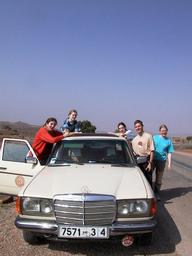
|
Wednesday morning we took a taxi to Azilal, a small town about 200 km
to the west of Marrakech. That would be the starting point of our five
days of hiking through the High Atlas mountains. We had reserved the
taxi and negotiated the price beforehand and later found out that in
this country it's a mistake which leads to paying double or triple the
standard price.
|
The big taxi network in Morocco is a really practical way to get
from one place to another. The cars circulate continuously between
major cities and have standard prices, although sometimes try to ask a
bit more from tourists. The prices are always per person and if the
group is smaller than the capacity of the car, you have to either wait
for more passengers or pay for the empty seats also.
It is best to walk or take a small taxi to the main traffic station
and not to accept any offers on the way. The place is always full of
taxis that have already decided among themselves which one is going to
which direction - ask around to find the right car. The taxis don't
always have a sign on the roof but are all the same color in the same
city and thus easy to distinguish. The most common models are old
Mercedes and Peugeots and they have the right to take six passengers
in, two in front and four in the rear. But as the price is around
25-30 DH per person for 100 km it isn't too expensive to pay for the
whole car for a group of four or five.
At Azilal we met Christelle's friend Hamid who had kindly taken a
day off to help us organise the start of the hike. We had reserved a
local guide with mules to carry most of the material. The primary
reason wasn't laziness but to take advantage of the locals' experience
of the region and hope to get to know their lifestyle. Now we heard
from Hamid that it would actually be three people, one per each mule
and they would also prepare the food for us.
The mountains are inhabited mostly by berbers, which is a different
people than the arabs. The berbers generally have a more relaxed way
of life and even their own language which has nothing to do with arab.

|
The Mercedes changed to a 4x4 Land Rover and after buying some
fruit and vegetables we took the road towards Iskatafen, a small
village a bit further away.
|

|
The road went up and down the mountains being first asphalted but
turning to sand about midway. The scenery was magnificent, small farms
between the hills and the mountains, a small river flowing in the
bottom of the gorge, children looking and waving after us. We even had
tea in a small hut on the way, I wonder how that business is
profitable as the road wasn't actually filled with tourist buses and
not even with other cars.
|
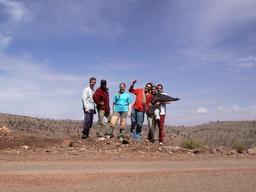
|
Our group photo next to the road, Hamid is the second from the left.
|
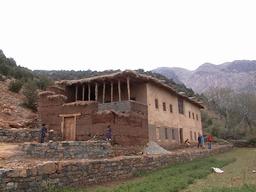
|
We arrived late afternoon and installed in one of the typical brown
houses. The difference from hectic Marrakech was striking. No more
traffic noise, no more shopkeepers in every corner trying to sell
something. Children standing next to the houses trying to hide their
curiosity towards us and contemplating whether they could come
closer. Fresh home-baked bread and butter.
|
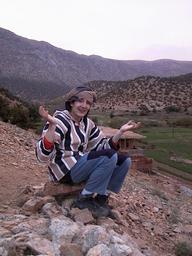
|
Christophe was still too white to merge into the local population but
had at least put on some appropriate clothing. Don't worry, be happy!
|
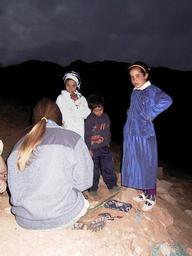
|
After a while the curiosity took over and the children approached
us. The families certainly weren't rich but they were still nicely
dressed. Communication was a bit more difficult, the people outside
cities don't always speak French very well and our group still a lot
worse arab and berber. Hamid knew all three and translated when
necessary. Magali drew a couple of nice pictures and we sat outside
late enjoying the moonlight.
|

|
On Thursday we woke up at 7 and started our long-awaited hike an hour
later. The mules seemed to us to be quite heavily loaded but the
owners said it was about the normal amount. In any case it didn't
really feel like doing any sports carrying just our small backpacks
containing only water and other necessities for the day.
|

|
We climbed from just under 1900 to 2900 meters and descended to 2200
in another valley, total lenght being about 20 km. The dust and dry
air irritated the throat a bit, but all things considered it was an
easy walk. The huge plate of vegetables we had for lunch prepared by
our mule owners confirmed that the week would be far away from an
ascetic journey through the dry land.
|
There were small trees up to about 2500 and small patches of snow
before the highest point, but mostly the vegetation consisted of small
20-30 cm high bushes, adapted to the dry climate.

|
Brahim took charge of the kitchen and surpassed all our expectations
with a sumptuous dinner of couscous. After eating we asked them to
sing some local songs for us and they agreed. We sung some French ones
for an answer (although I didn't know the words of most of them) and
so started the musical evenings that would last during the whole
trip. Plates, spoons and other kitchen equipment made good drums and
Mohammed even started dancing and invited us to join.
|
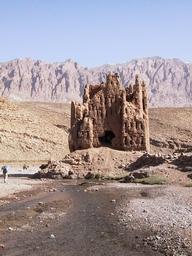
|
This "sand castle" was right next to our camping place, it was
interesting to explore the ruins during the night. You can also see
the small river that we started to follow.
|
Friday didn't bring anything really amazing from a landscape point
of view. We traversed several villages and this time the kids weren't
shy at all. It was a bit painful to continue with two dozen 3-10 year
olds running around and asking pens, money or other things.
"Donnez-moi un stylo" was a phrase that we heard many, many times. We
weren't equipped with a few hundred ballpoint pens but gave out some
candy.
I hadn't been feeling very well since the morning and after the
lunch my stomach decided that the best way to be is empty. It
proceeded with that plan rather effectively using both available exits
and for the last few kilometers I was forced to ride on one of the
mules.

|
I continued on the mule still the next day when we arrived to the most
beautiful part of the hike, the canyons of M'Gouna. It's not as well
known as the Todra, but magnificent too: the narrow passages are about
5 meters wide and the stone walls rise straight up to about 50
meters. The sides show the results of water forcing its way through -
rounded corners, small caves.
|
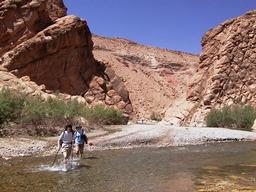
|
On Sunday I wasn't sick any more and joined the others in the
walk. The riverbed wasn't as narrow as the previous day but it made
tight turns several times and we had to cross the stream quite
often. My hiking shoes weren't very well suited to that. Usually I
succeeded in finding a place with some rocks and keep my feet dry but
occasionally it was too deep and the goretex film made sure that the
water that went in also stayed there until I took the shoes off. Well,
sometimes you don't guess beforehand the best equipment and have to
take things as they come.
|
The mountains were also very different from those in the beginning
of the hike. There were few plants on the slopes and the red color
made them look a lot like the pictures I've seen of the Grand Canyon.
As we continued to follow the river there weren't any major
altitude differences, but the distance was rather long: 30-35 km. I
sure was tired after that. Mathieu still had the courage to walk about
half a kilometer back to the center of the village to get me some
bottled water. To avoid all risks I hadn't been drinking any water
from the river since my stomach problems despite we had tablets that
should make it safe.

|
On Monday, the fifth day of the hike we arrived to Kelâa M Gouna
already before noon. We paid and reluctantly said good bye to the
mule-owners - we had really been treated like kings during the
week. From the left: Brahim, Lhoussin, Omar (who travelled with us
without pay, apparently training) and Mohammed.
|
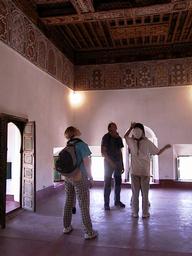
|
We took a taxi to Ouarzazate (now paying the right price) and hopped
off at the kasbah just outside the town. Kasbahs are castlelike
buildings or groups of buildings constructed by various dynasties over
the centuries. The kasbah at Ouarzazate was mostly painted white from
the inside but in some places we could see some pieces of the original
interiors. The architecture was quite a labyrinth.
|
We didn't spend a lot of time at Ouarzazate and took the taxi back
to Marrakech still the same day. 200 km on the curvy mountain road
took 4 hours and we arived at about 8 pm, again at hotel Farouk. We
were too tired to go to the center but went to the restaurant of the
hotel for a good meal to celebrate the end of our hike. It was good
and the service superb, nothing to complain about.
Page:
1 |
2 |
3 |
next >>
Copyright Arto Teräs
<ajt@iki.fi> 2001.
Redistribution of this document as a whole or any of the pictures
individually is permitted in any medium provided this copyright
notice is preserved.
Last update 17.8.2001.
